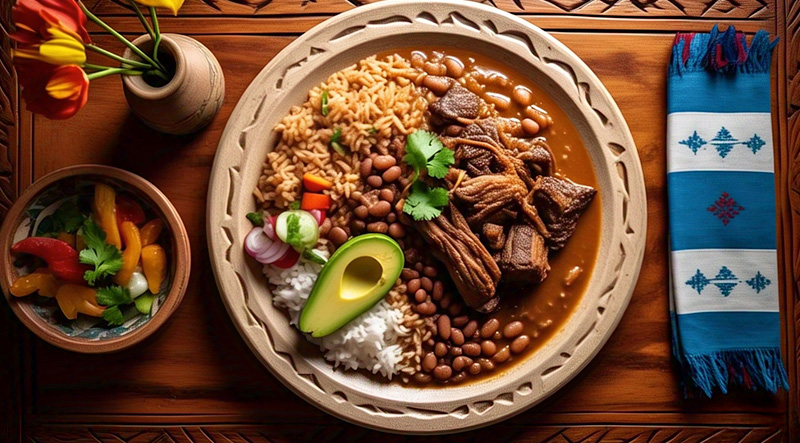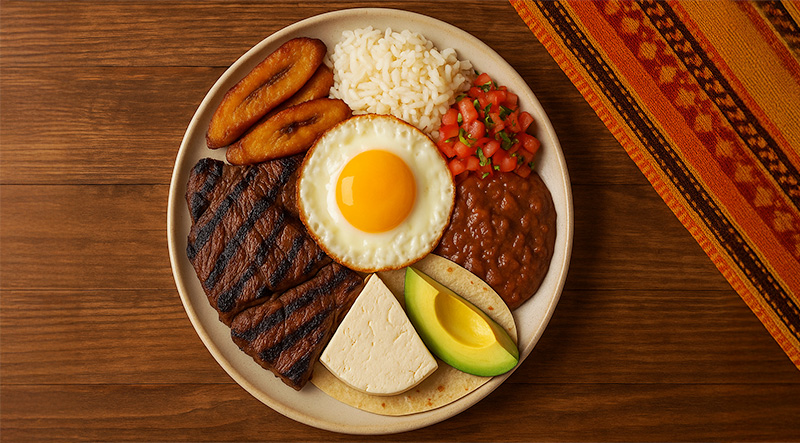Plato Típico is the essence of Honduran cuisine; it is vibrant, flavorful, and bold. Juicy grilled beef, golden fried plantains, creamy refried beans, fluffy rice, tangy fresh cheese, ripe avocado, and warm corn tortillas are all combined on one colorful plate in this all-in-one national dish. Plato Típico, which is frequently garnished with chimol, a spicy tomato salsa, is a celebration of custom, coziness, and community. Every mouthful of this rustic classic, whether it is consumed at a roadside restaurant or at a family table, narrates a delectable tale of Honduras' rich culinary legacy. Read More...
The History of Honduras’ National Dish -Plato Típico:
Plato Típico, literally meaning “Typical Plate,” is much more than a common meal in Honduras—it’s a culinary symbol of national identity. This hearty and colorful dish, composed of grilled meat, refried beans, rice, fried plantains, cheese, avocado, and corn tortillas, reflects the country’s deep-rooted history, diverse geography, and multicultural influences. From indigenous Lenca traditions to Spanish colonial flavors and African contributions, Plato Típico is a delicious fusion that has stood the test of time.
Indigenous Foundations:
The origins of Plato Típico can be traced to pre-Columbian civilizations, especially the Lenca and Maya peoples who cultivated maize, beans, plantains, and squash. Corn, a sacred crop in Mesoamerican cultures, continues to be central to the dish today in the form of handmade tortillas. Beans—another staple—were often boiled or mashed and eaten with vegetables or chili peppers. These humble but nutritious ingredients laid the foundation for what would become a national favorite.
Spanish Influence and the Addition of Meat:
With the arrival of the Spanish in the 16th century, new ingredients and cooking methods were introduced, including cattle, pigs, rice, and European-style cheese. This led to the inclusion of grilled beef (carne asada) and queso fresco in local meals. Rice, often grown in the lush lowlands of Honduras, became a staple side. The fusion of European and indigenous ingredients gave rise to meals that were both practical and festive.
African Contributions:
Honduras’ Afro-Caribbean Garífuna communities, particularly along the northern coast, brought additional flavor to the national cuisine. While the Garífuna version of Plato Típico might include seafood or coconut-based components, the widespread use of plantains and cooking techniques such as frying also reflect African culinary influence.
A Dish of Celebration and Comfort:
Originally a meal for special occasions or communal gatherings, Plato Típico gradually became a staple in homes, roadside diners, and traditional restaurants (comedores típicos). It’s often served during national holidays, family reunions, or Sunday lunches—moments when people gather to enjoy a satisfying meal together. Its balanced mix of protein, carbs, and vegetables makes it a complete and fulfilling dish.
Regional Twists:
Though the basic components remain consistent, regional variations of Plato Típico showcase the dish’s adaptability. In the highlands, it may feature chorizo or pork, while coastal versions highlight fried fish or seafood. Some renditions include a spicy tomato-onion relish called chimol, while others might add a fried egg on top.
A National Icon:
Today, Plato Típico stands as a culinary emblem of Honduras. Its widespread popularity and consistent presence in both rural homes and urban eateries highlight its role in uniting the country’s diverse regions and cultures. Each serving not only satisfies hunger but also tells a story—of land, labor, family, and history. Whether served on a banana leaf in the countryside or plated elegantly in a Tegucigalpa restaurant, Plato Típico remains the soul food of Honduras.
Marinate the Beef:

Cook the Rice:
Prepare the Refried Beans:
Fry the Plantains:

Grill the Beef:
Warm the Tortillas:

Assemble the Plato Típico – On a large plate:
The total preparation and cooking time for Plato Típico is approximately 1 hour and 15 minutes. This includes around 20–30 minutes of marinating the beef (which can be extended for more flavor), 20 minutes to cook the rice, 15–20 minutes to prepare and mash the refried beans, and about 10–15 minutes to fry the plantains and cook the beef. Warming the tortillas and assembling the plate takes another 5–10 minutes. If you include a fried egg, it adds just an extra 5 minutes. With good multitasking, several components can be cooked simultaneously to reduce total time.
A single serving of Plato Típico with grilled beef, refried beans, white rice, fried plantains, avocado, fresh cheese, a corn tortilla, and a fried egg contains approximately 800 to 950 calories. The grilled beef provides protein and fat (about 250–300 calories), while the refried beans and rice contribute a combined 250–300 calories. Fried plantains add around 150–200 calories, the tortilla about 100 calories, and the egg approximately 70 calories. The avocado and cheese contribute healthy fats and add around 100–150 more calories, depending on portion size. Variations in preparation, especially the use of oil or lard, can affect the total calorie count.







